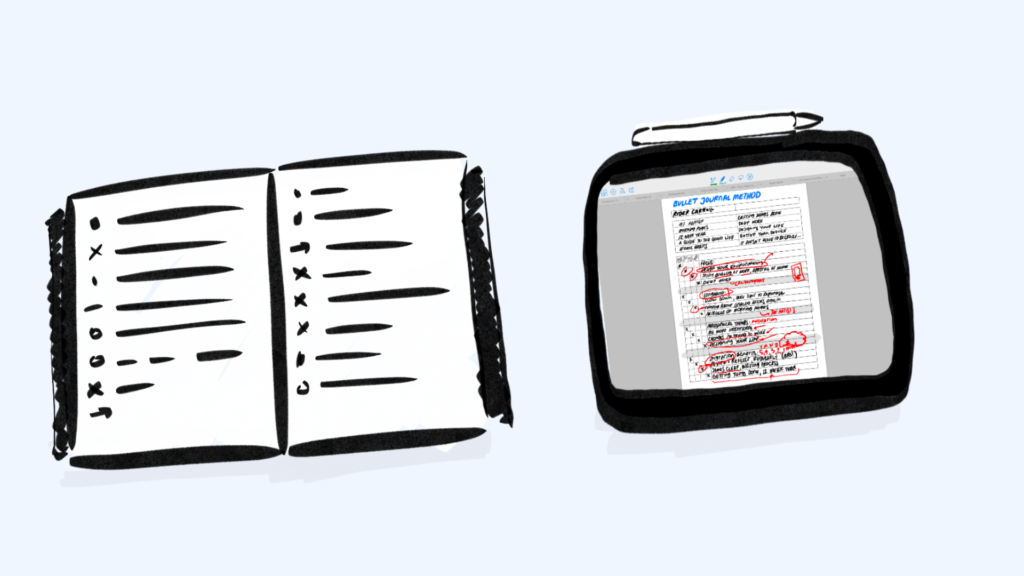
Check out the full notes for “The Bullet Journal Method: Track the Past, Order the Present, Design the Future” by Ryder Carroll
What if you had the power to do most things? What if you had the power to do one specific thing nobody else could do?
Superman can do just about anything. But mayyyybe you just need to fit into a very tiny space.
Alright, so we’re talking about productivity, not superhero powers. There might be some downsides to software, as Ryder Carroll explains in The Bullet Journal Method: Track the Past, Order the Present, Design the Future:
Another reason we use notebooks? Flexibility. Software tends to be either so powerful that its wealth of features is buried to all but the most intrepid explorers (think Excel) or so specific that it sacrifices features for increased usability, essentially doing few things very well (think mobile apps).
The solution, of course, is an analog notebook.
Notebooks, in contrast, are beholden to their authors. Their function is limited only by the imagination of their owner.
Some of the friends I have with bullet journals are the same people who would say “oh I can’t draw”. They feel okay being creative within the confines of a journal. It’s a safe space.
Technology makes it too easy to do some things
Jotting a note down? Easy in an analog notebook. It’s also easy on a digital device.
Sending it to the cloud so you can access that note on all the devices you have anywhere in the world? Having its contents searchable so that you can pull it up from your pile of other notes? Easy on a digital device.
Too easy. To the point that we can become a little thoughtless about what we put in that pile. It’s hard to review an infinite pile of notes.
There can be value in a little bit of friction. If it takes a little more effort to summarize your thoughts before writing them into a notebook, then you’ll do a little bit of filtering up front. Less to review means you’ll be more likely to review it.
Keeping a longhand notebook, digitally
You can get some of the benefits of slowing down by doing longhand writing digitally. Since reading the book, I’ve been keeping an analog journal for work and for everything else I keep a digital journal in my iPad.
It’s not the same. I knew that going in, but now I have a better sense of what the differences are.
Keeping a digital notebook is like having a 3-ring binder. There are pros and cons.
You’re not forced into the permanent linear order of an analog notebook. When you’re combining a collection of your work and other research and want to keep it organized in different categories, digital tools shine.
For something like a bullet journal, a lot of the pleasure comes over time as you open the notebook up day after day and build up your spatial memory of where things are. You can’t use a search query but you can flip to your monthly log in a few moments.
One of the advantages physical books continue to have over eBooks is that rifling through pages is easier. The Kindle app has improved here to where you can skim pages without losing your place in a book. But flipping back and forth between 2 or 3 pages is still easier with a physical book, keeping your place with your fingers.
The bullet journal review process is easier with an analog notebook.
Longhand writing, slowing down, and calmness
If you’ve heard of bullet journals, there’s a good chance you’ve heard of morning pages. It’s a form of journaling but quite different from the bullet journal. Instead of summarized bullets, you let it all out unfiltered. Three pages a day, longhand.
In The Miracle of Morning Pages, Julia Cameron answers the question “Must I really write pages longhand?”
Again, yes. Pages must be done longhand. The computer is fast—too fast for our purposes. Writing by computer gets you speed but not depth. Writing by computer is like driving a car at 85 mph. Everything is a blur. “Oh, my God, was that my exit?” Writing by hand is like going 35 mph. “Oh, look, here comes my exit. And look, it has a Sonoco station and a convenience store.”
The same reasoning applies to bullet journals as well. It’s calm.
It’s one of the best things about keeping a bullet journal. The great thing is that it’s one of the things that translates best from analog to digital. Longhand writing with the Apple Pencil is a pleasure.
Just turn your notifications off.
(And think espresso, not coffee)
